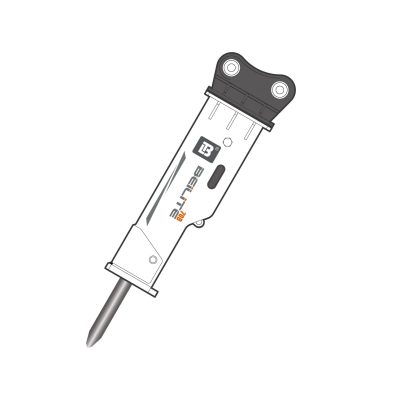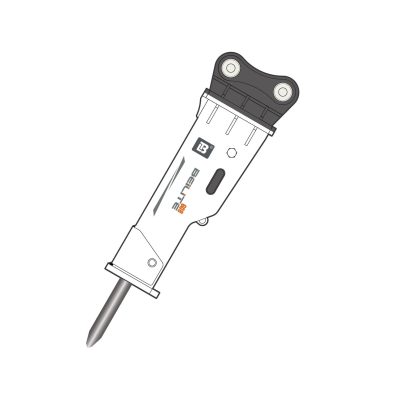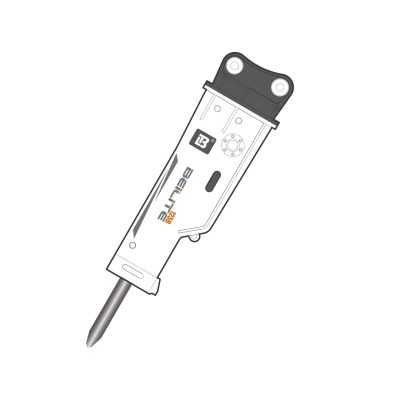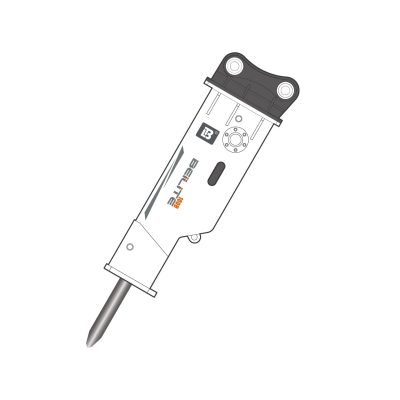What is a Hydraulic Breaker?
A hydraulic breaker is a powerful impact tool that uses hydraulic energy to deliver high-frequency, high-force blows. Engineers typically attach it to construction machinery such as excavators. They also call it a hydraulic hammer, rock breaker, breaker head, or impact hammer. It converts pressurized hydraulic oil into repetitive mechanical strikes to demolish hard materials like concrete or rock.
Manufacturers design hydraulic breakers as attachments, not standalone machines. These breakers depend on the host machine’s hydraulic system to function. The system delivers hydraulic oil under pressure to activate internal components and initiate a controlled impact cycle.
Each hydraulic breaker contains several key components:
Housing: Encloses internal parts and protects them from external damage.
Cylinder: Guides and contains the movement of the piston.
Piston: Strikes the tool rod to generate impact energy.
Accumulator (Gas Chamber): Stores energy using pressurized nitrogen and helps regulate hydraulic pressure.
Chisel (Tool Rod): Transfers the impact to the surface; comes in various shapes such as flat, moil, or cone.
Hydraulic Ports: Connect to the carrier machine’s hydraulic hoses.
Control Valve: Regulates oil flow direction and cycle timing.
The host machine—whether it’s an excavator, backhoe, or demolition robot—provides hydraulic oil flow and pressure. This energy powers the breaker, making it highly adaptable across construction, mining, and demolition sectors.
Applications of Hydraulic Breakers
Operators use hydraulic breakers in multiple industries. These tools deliver powerful and focused impacts, making them ideal for tough jobs.
1. Rock and Ore Breaking
In mining and quarrying, workers use hydraulic breakers to:
Split oversized boulders and expose mineral veins.
Break ore during surface and underground extraction.
Open tunnels and underground caverns.
Reduce rocks to manageable sizes during foundation works.
2. Concrete Structure Demolition
Construction professionals rely on breakers to dismantle:
Buildings, bridges, and overpasses.
Airport runways, concrete pavements, and industrial floors.
Thick reinforced concrete blocks during reconstruction.
This method provides precise control, especially in urban zones or sensitive areas.
3. Frozen Soil and Asphalt Pavement Removal
In cold regions, operators use breakers to:
Excavate permafrost or frozen clay.
Shatter and remove old asphalt surfaces during roadwork.
Breakers allow road crews to maintain timelines in challenging climates.
4. Secondary Rock Breaking
After initial drilling and blasting, hydraulic breakers help:
Split oversized rock fragments.
Process and clear blast debris.
This stage increases efficiency and reduces manual handling.
5. Trench Excavation and Wall Shaping
When digging through hard soil or rock, workers use breakers to:
Excavate narrow trenches for pipes or cables.
Shape trench walls precisely.
In some cases, breakers replace drilling or blasting for safer operation near structures or utilities.
6. Specialized and Industrial Uses
Some industries apply breakers in non-standard settings:
Underwater demolition with specially sealed models.
Furnace slag processing in steel plants.
Breaking pile heads for foundation adjustments.
These tools adapt to niche needs with custom tool rods and sealed components.
How a Hydraulic Breaker Works
Hydraulic breakers operate using a controlled energy conversion cycle. The core principle involves converting hydraulic energy into mechanical impact force.
The Impact Cycle
1. Retraction Stage
The machine’s hydraulic system directs pressurized oil into the lower part of the cylinder. This flow pushes the piston upward, while the accumulator compresses nitrogen gas, storing energy.
2. Compression Stage
Once the piston reaches its top point, the control valve switches the oil path. Pressure in the lower chamber drops, and oil flows into the upper chamber. Simultaneously, compressed nitrogen gas expands rapidly.
3. Impact Stroke
The piston receives force from two sources: pressurized oil from above and expanding nitrogen gas from behind. This dual force drives the piston downward at high speed, striking the chisel.
4. Rebound and Reset
After impact, recoil force briefly lifts the piston. The control valve resets oil flow, starting the next cycle.
Key Components in Action
The accumulator boosts piston speed, stores energy, and smooths pressure fluctuations.
The control valve ensures timely switching between pressure zones.
The tool rod delivers the piston’s impact force to the target surface.
This cycle repeats several hundred to thousands of times per minute, depending on the breaker’s model and settings.
Advantages of Hydraulic Breakers
Hydraulic breakers offer multiple benefits for contractors, operators, and project managers.
1. High Efficiency and Power
These tools deliver strong impact energy. As a result, they break hard materials faster than manual tools or pneumatic hammers. Operators finish more work within shorter cycles.
2. Precision Control
Users can adjust strike force and frequency. This flexibility minimizes damage to nearby structures and enables fine demolition in confined areas.
3. Cost-Effective and Environmentally Safer
Compared to blasting, hydraulic breakers:
Eliminate permit requirements for explosives.
Avoid flying debris and ground shockwaves.
Generate less dust and noise.
This reduces environmental disruption and improves worksite safety.
4. Broad Compatibility
Manufacturers design breakers for compatibility with many carriers:
Mini, midi, and full-size excavators.
Wheel loaders and backhoes.
Specialized demolition equipment.
With the correct bracket and hydraulic settings, operators can switch between tasks efficiently.
5. Mobility and Flexibility
Once mounted, the breaker moves wherever the host machine goes. It can quickly shift between multiple work zones, especially in large construction sites.
6. Improved Operator Safety
Operators remain inside cabin enclosures, reducing exposure to noise, vibration, and dust. The risk of explosive accidents also disappears, especially in populated areas.
7. Better Work Conditions
Unlike handheld tools, mounted breakers reduce physical strain. This improves worker health and long-term productivity.
Additional Considerations
Selecting the Right Breaker
Choose a breaker based on:
The carrier’s flow rate and pressure.
The material hardness and jobsite size.
Required tool rod shape.
Desired impact energy and frequency.
Availability of spare parts and after-sales support.
Safe Operation Practices
Operators must:
Wear protective equipment.
Avoid dry firing (operating without surface contact).
Strike perpendicularly to prevent tool damage.
Monitor chisel wear and replace when necessary.
Perform routine maintenance.
Maintenance Guidelines
A well-maintained breaker delivers consistent performance. Regular checks include:
Hydraulic oil level and filter condition.
Nitrogen pressure in the accumulator.
Bolt torque and structural cracks.
Tool rod lubrication and replacement cycles.
These steps prevent downtime and extend equipment life.
Discover Beilite Hydraulic Breakers
Beilite offers a wide range of hydraulic breakers for mining, demolition, and construction. Our products fit major excavator brands and meet high durability standards. We provide:
Reliable after-sales service.
Full technical support.
Fast spare parts supply.
Expert application guidance.
📩 Contact Beilite today for pricing, models, and professional consultation. Let us help you find the right breaker for your project.
Frequently Asked Questions
How do I choose the right hydraulic breaker for my excavator?
Match the breaker to your excavator’s hydraulic flow, operating pressure, and carrier weight. Also consider the task type, such as rock breaking or concrete demolition. Beilite experts help match breakers to your project needs.
How often should I service a hydraulic breaker?
Check hydraulic oil, accumulator pressure, and tool wear weekly under heavy use. Follow the maintenance schedule in the manual. Timely servicing extends the breaker’s lifespan and ensures safety.
Can I use a hydraulic breaker underwater?
Yes, but only with specialized models. Underwater breakers include sealed housings and pressurization systems to prevent water damage. Use correct grease and follow specific underwater procedures.
What are the common shapes of tool rods?
Common types include pointed chisels (for hard rock), flat chisels (for concrete), and blunt chisels (for compacted materials). Each tool suits different materials and breaking strategies.









